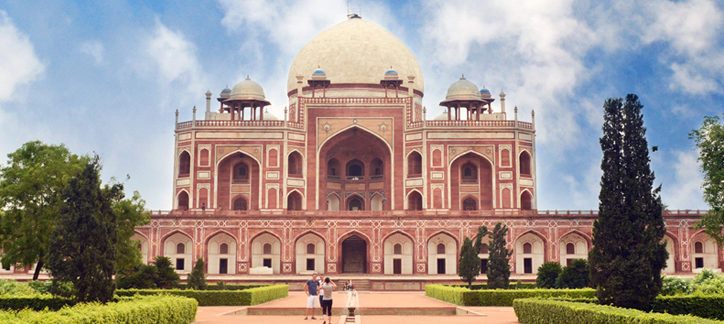Humayun's Tomb Travel Information
Humayun Tomb Description:
Humayun’s Tomb is one of the most prominent attractions and cultural landmarks in the Indian city of Delhi. The Tomb of Humayun is the last resting place of the 2nd great Mughal Emperor, Humayun and has been placed on the prestigious UNESCO World Heritage Site list since 1993.
The Tomb of Humayun is considered the first of many garden tombs built by the reigning Mughal Dynasty of India and is widely believed to be the inspiration of many of the wonders of Mughal architecture in South Asia including Akbar’s Tomb, Itimad-ud-Daulah Tomb as well as the matchless Taj Mahal.
Being the first of its kind, the Tomb of Humayun set a number of precedents that are now recognized as staples of Mughal architecture and appreciated around the world. These include the use of symmetry and minimalism on the outside and a complex patterned interior on the inside. Building skills such as the widespread use of the Pietra Dura art form as well as the prolific use of precious stonework and Arabesque calligraphy were applied to a mausoleum at such a grand scale for the first time during the construction of Humayun’s Tomb.
Completed in the year 1572 AD, the Tomb of Humayun was built over a period of eight years and required the use of 20,000 laborers many of whom were master craftsmen and were engaged to work in the project from regions as far afield as Central Asia, Persia and Arabia. To lift the heavy building materials and transport construction supplies, an army of 1,000 elephants was dedicated to the project.
Historians agree that the building of Humayun’s Tomb brought an unmistakable Persian influence to Mughal architecture. The tomb is one of the largest buildings to use red sandstone on such a massive scale in India. The main structure of the tomb is 47 meters high and 94 meters wide. The building is topped with a massive white bulbous double dome to provide a striking contrast to the red color of its exterior. The Tomb of Humayun was the first ever building in South Asia to use this unique Persian building technique which uses two layers on the dome, an outer Marble layer for aesthetics and an inner layer to create a cavernous structure to augment acoustics of prayer services inside the tomb. The dome of Humayun’s Tomb is topped by a 6 meter tall brass filial with an ascendant crescent.
The main burial chamber housing the grave of Humayun is a magnificent site and is again in stark contrast to the balance and minimalism of the exterior of the tomb. The main burial chamber of Humayun’s Tomb has an octagonal sepulcher right underneath the main dome with the Mughal emperor’s cenotaph at its center. The entire burial chamber is surrounded by rich stone lattice work, intricately made jaalis as well as prolific Pietra Dura stone in-lays. Complementing this kaleidoscope of design is extensive use of Arabesque and Islamic design patterns and calligraphy.
Many historians contend that the Tomb of Humayun was always designed as a dynastic mausoleum as it has over 124 vaulted sub chambers apart from the main tomb of the Mughal Emperor himself.
Here over a hundred members of the Mughal dynasty have been buried over the years including some prominent historic personalities such as the ill-fated Prince Dara Shikoh and at least five of the lesser Mughal Emperors who presided over the waning Mughal Empire in its nadir during the 18th and 19th centuries. This is the reason why the Tomb of Humayun is popularly dubbed as the “Dormitory of the Mughals”.
The Tomb of Humayun is surrounded by a large garden of 30 acres (13 hectares) which is called “Charbagh” meaning four gardens. As the name suggests, the garden is Persian styled with a quad-lateral layout. The four gardens are then connected with four major walkaways called “Khayabans” and have two major water channels with bisecting intersections. Historians believe that the garden of Humayun’s Tomb has been designed in line with the Islamic concept of Jannat or paradise. The garden was the sight of a number of major events in the history of India, the most famous of which was the surrender of the last Mughal Emperor to British authorities, an act which brought to a close over three centuries of Mughal rule in India.
There are a number of attractions in the immediate periphery of the Tomb of Humayun which are worth seeing on any trip to the mausoleum. These include the famous Barber’s Tomb (Nai Ka Maqbara) which contains an unmarked yet resplendently decorated grave that is assumed to be the tomb of the favorite barber of Emperor Humayun. Another tomb nearby is called the Bu Halima Garden. This garden tomb again belongs to a woman who is assumed to be of noble birth considering the scale of the tomb and its design intricacy. However there is no mention of the occupant in any of the major chronicles of the period thereby leaving historians guessing as to her importance in Mughal society.
The oldest structure in the Humayun’s Tomb Complex is the Isa Khan Tomb and Mosque, another well-made and intricate structure that predates the Tomb of Humayun by at least a quarter of a century and is said to have belonged to Isa Khan, a nobleman of the Sur Dynasty that has wrested control of Delhi from the Mughals for a short period.
Other major structures in the immediate periphery of the Tomb of Humayun include the Afsarwala Tomb and Mosque which is a smaller yet impressive structure housing a mosque and a tomb of a nobleman of Akbar’s court, the successor to Emperor Humayun. Also in the same area is the Nila Gumbad or Blue Dome which is another tomb of a nobleman of Emperor Akbar and has been designed with painstaking detail in a more Central Asian as opposed to Mughal theme thereby giving visitors an interesting photo-opportunity.

On the southern edge of the Humayun Tomb Complex lies the Arab Serai. This is a gigantic rest house which was built to house the Arab master artisans who had come to India to work on the Tomb of Humayun and gives visitors an insight into the scale of the project.
Just outside the Humayun Tomb Complex to the northeast lies the Chillah Niazamuddin Auliya which is the historic home of the patron saint of Delhi. This is a site of pilgrimage for many devotees that over time have included emperors, conquerors, celebrities as well as people from all walks of life.
The Tomb of Humayun has been the subject of many restoration exercises through the ages all of which have added to the grandeur of the monument.
Best Time to Visit Humayun Tomb:
While India gets tourists around the year, many seasoned travelers who love Delhi claim that the best time to visit the city and take in its major monuments such as the Tomb of Humayun is best done between October and March when the weather is very pleasant and the monsoon rains have passed over India.
The Tomb of Humayun is open every day of the week from “dawn to dusk”, therefore times vary depending on when you visit India. For the seasoned travel photographer, the best time to capture the intense beauty of Humayun’s Tomb is either early morning or just before sunset when the red sandstone façade of the building is best highlighted by the dimming rays of the sun.
How to get to Humayun Tomb:
Humayun’s Tomb is located in Delhi, India’s bustling federal capital and the largest metropolis in North India. The city is conveniently accessible from all major international destinations and is serviced by a variety of international airlines through the Indira Gandhi International Airport.
Humayun Tomb Highlights:
The Tomb of Humayun would be of interest to fans of history, particularly of India under the great Mughals. Also tourists interested in art, architecture and building aesthetics would find the site attractive considering its impact on Indo-Saracen architectural influences.
Furthermore, the scale of the monument and so many points of interest in the immediate vicinity are a great opportunity for all photo enthusiasts so take some phenomenal shots of a multitude of monuments in a short time span.
Appropriate Attire:
It is worth noting that most tourists visit Humayun’s Tomb as part of the an extended tour of Delhi that includes visits to various shrines and religious sites as well which require clothing that cover knees and shoulder for both males and females and may require female visitors to cover their heads.
Also slip-on shoes and socks particularly in summer months may aid visitor convenience and comfort when visiting multiple attractions in Delhi along with the Tomb of Humayun.

